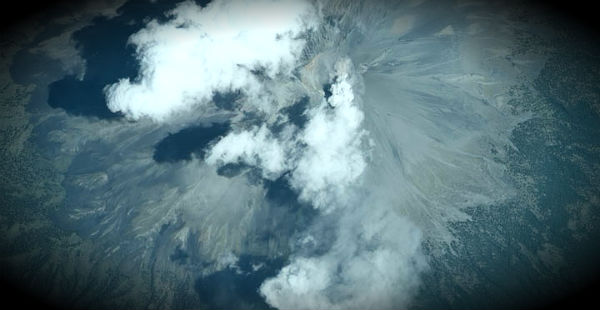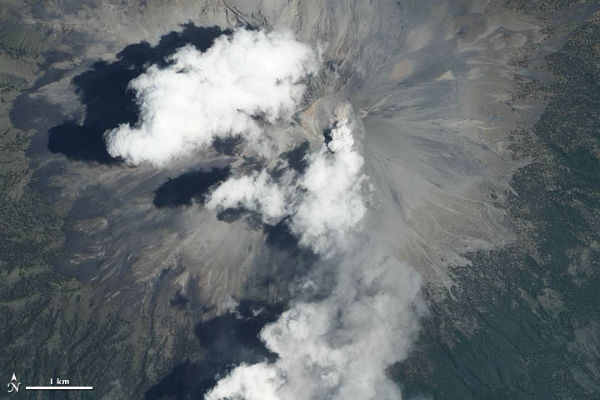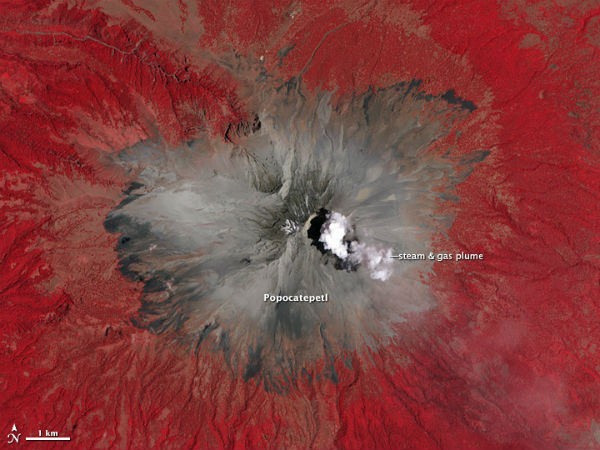Activity at Popocatépetl continues

Popocatépetl, which means “smoking mountain” in the Aztec language, has seen low to moderate levels of activity throughout the past week. Activity began to intensify in mid-April 2012 Plumes have wafted from the volcano; an especially dense ash plume emerged on April 20th and drifted east at an altitude of 1.5 kilometers (0.9 miles). On April 18 and April 23, explosions sent hot, glowing rock fragments as far as 800 meters (874 yards) from the main vent; some of these fragments produced small mudslides, known as lahars.
Popocatepetl volcano registered an exhalation of moderate intensity that was accompanied by emissions of water vapor, gas and ash, heading southwest, reaching a height of 600 m. From the morning volcano showed continuous emission of steam and gas. Popocatepetl seismic activity has remained stable in last 24 hours, with episodes of low amplitude spasmodic tremor. Popocatepetl has been relatively calm, showing only 12 low-intensity exhalations, which were accompanied by emissions of water vapor, gas three times and only moderate amounts of ash. A spasmodic tremor episode of small amplitude is still happening, and has generated a plume of gases and fine ash that goes to the southwest due to strong winds.

The volcanic alert level remains at Phase 3 – Yellow Alert Level. This implies the probability of observing the following scenarios: Explosive activity of intermediate-scale high dome growth and possible expulsion of lava, explosions of increasing intensity and rains ash on notorious nearby towns. CENAPRED issued advice of safety radius of 12 km, start to control traffic between Santiago and San Pedro Nexapa Xalitzintla via Paso de Cortes.
Popocatepetl Volcano monitoring is performed continuously 24 hours.
Located about 70 kilometers (40 miles) southeast of Mexico City, Popocatépetl is one of Mexico’s most active volcanoes. The towering stratovolcano has been erupting since January 2005, with near constant venting from fumaroles, punctuated by minor steam, gas, and ash emissions.

A plume of steam and ash blows south from the volcano’s main vent. The ongoing eruption has flung hot rock fragments onto the northeast flank of the mountain, and a tan patch of what is probably new material—tephra—is visible just north of the main vent. Older lava flows are visible cutting into forests on the western slope. A portion of a cloud northwest of the main vent obscures part of the plume.

On April 25, 2012, Mexico’s National Center for Disaster Prevention (CENAPRED) reported that Popocatépetl released bursts of steam, gas, and ash into the atmosphere at 1:00 p.m. and 5:26 p.m. local time; more than 13 low intensity “exhalations” of steam and gas occurred on the 26th, but only three contained ash.
Popocatepetl volcano is situated between two large population centers: Mexico City (19 million) and Puebla (2.6 million). The region’s dense population means a serious eruption could have grave consequences. At a recent press conference, CENAPRED Director Roberto Quaas said scientists have no way of predicting whether the molten rock in the chamber will be slowly released or if it will erupt in a powerful explosion.
NASA’s Satellite Movie of One Week’s Ash Activity from Mexico’s Popocatépetl Volcano


Commenting rules and guidelines
We value the thoughts and opinions of our readers and welcome healthy discussions on our website. In order to maintain a respectful and positive community, we ask that all commenters follow these rules:
We reserve the right to remove any comments that violate these rules. By commenting on our website, you agree to abide by these guidelines. Thank you for helping to create a positive and welcoming environment for all.